Initial and Diagnostic Assessment Report for Call Center Employees
VerifiedAdded on 2021/04/21
|8
|1809
|440
Report
AI Summary
This report provides an in-depth analysis of initial and diagnostic assessments conducted for new call center employees. It defines the purpose of these assessments in identifying knowledge gaps and outlines the methods employed, including document analysis, observation, self-assessment, structured activities, and discussions. The report details the assessment process, including the selection of two learners, the communication of feedback, and the establishment of organizational reference points. It emphasizes the importance of recognizing and addressing individual learning needs to develop effective learning programs. The report concludes with recommendations for continuous assessment and the avoidance of assessment risks to ensure the ongoing professional development of the call center staff.
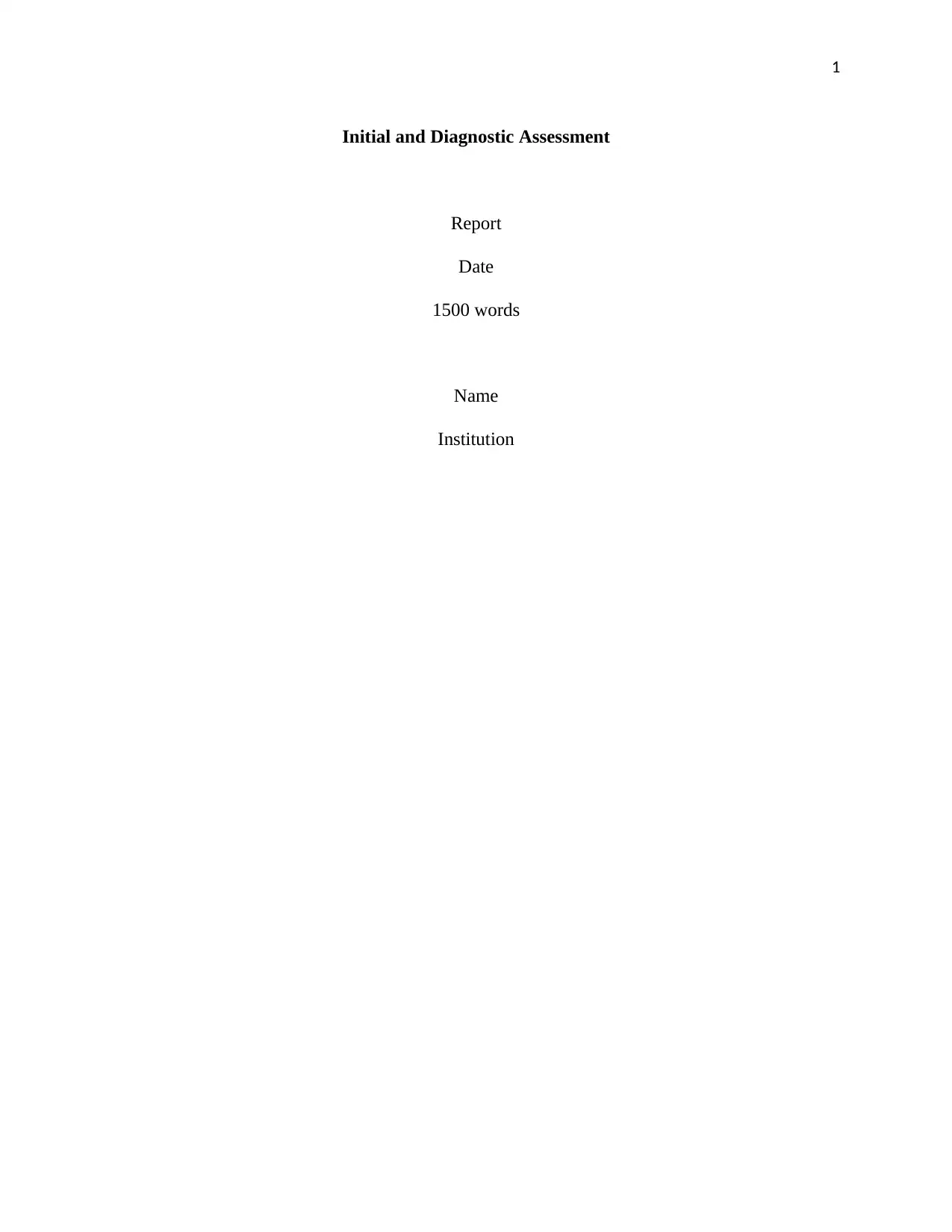
1
Initial and Diagnostic Assessment
Report
Date
1500 words
Name
Institution
Initial and Diagnostic Assessment
Report
Date
1500 words
Name
Institution
Paraphrase This Document
Need a fresh take? Get an instant paraphrase of this document with our AI Paraphraser
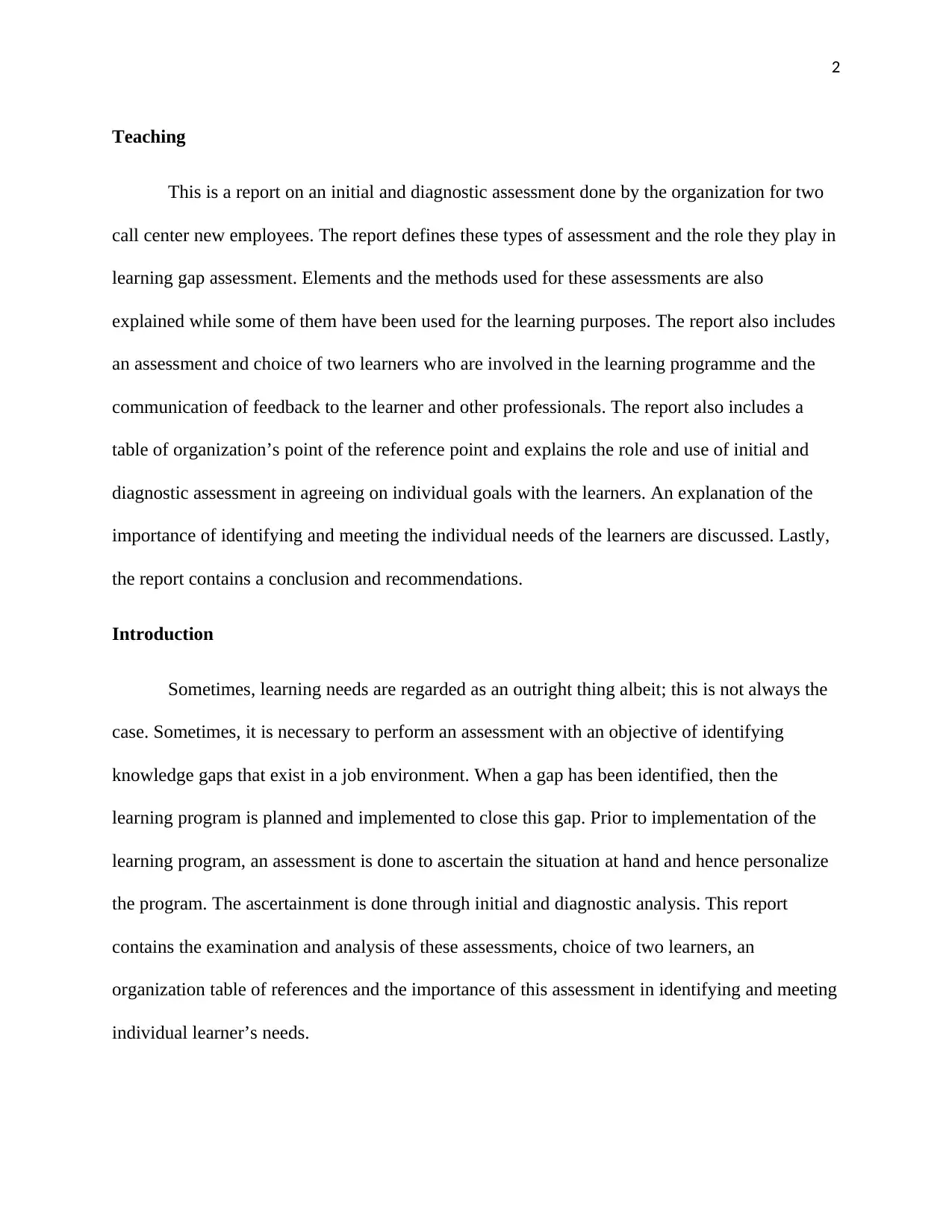
2
Teaching
This is a report on an initial and diagnostic assessment done by the organization for two
call center new employees. The report defines these types of assessment and the role they play in
learning gap assessment. Elements and the methods used for these assessments are also
explained while some of them have been used for the learning purposes. The report also includes
an assessment and choice of two learners who are involved in the learning programme and the
communication of feedback to the learner and other professionals. The report also includes a
table of organization’s point of the reference point and explains the role and use of initial and
diagnostic assessment in agreeing on individual goals with the learners. An explanation of the
importance of identifying and meeting the individual needs of the learners are discussed. Lastly,
the report contains a conclusion and recommendations.
Introduction
Sometimes, learning needs are regarded as an outright thing albeit; this is not always the
case. Sometimes, it is necessary to perform an assessment with an objective of identifying
knowledge gaps that exist in a job environment. When a gap has been identified, then the
learning program is planned and implemented to close this gap. Prior to implementation of the
learning program, an assessment is done to ascertain the situation at hand and hence personalize
the program. The ascertainment is done through initial and diagnostic analysis. This report
contains the examination and analysis of these assessments, choice of two learners, an
organization table of references and the importance of this assessment in identifying and meeting
individual learner’s needs.
Teaching
This is a report on an initial and diagnostic assessment done by the organization for two
call center new employees. The report defines these types of assessment and the role they play in
learning gap assessment. Elements and the methods used for these assessments are also
explained while some of them have been used for the learning purposes. The report also includes
an assessment and choice of two learners who are involved in the learning programme and the
communication of feedback to the learner and other professionals. The report also includes a
table of organization’s point of the reference point and explains the role and use of initial and
diagnostic assessment in agreeing on individual goals with the learners. An explanation of the
importance of identifying and meeting the individual needs of the learners are discussed. Lastly,
the report contains a conclusion and recommendations.
Introduction
Sometimes, learning needs are regarded as an outright thing albeit; this is not always the
case. Sometimes, it is necessary to perform an assessment with an objective of identifying
knowledge gaps that exist in a job environment. When a gap has been identified, then the
learning program is planned and implemented to close this gap. Prior to implementation of the
learning program, an assessment is done to ascertain the situation at hand and hence personalize
the program. The ascertainment is done through initial and diagnostic analysis. This report
contains the examination and analysis of these assessments, choice of two learners, an
organization table of references and the importance of this assessment in identifying and meeting
individual learner’s needs.

3
Initial and diagnostic assessments are methods used to assess the learners in the initial
stages of a learning programme. Initial assessment involves determining the current student level
of knowledge and skills at the beginning of a learning program. An initial assessment can be
done to determine the knowledge, for example, the knowledge that was acquired in school and
competencies therein. The learner’s knowledge can be assessed here by going through their
certificates and awards which sheds light on the knowledge, abilities, and skills that the potential
learner already possesses ( Zaidi Meeting the Assessment Requirements of the Award in
Education and Training) 1. Since this is the first stage of contact with the learner, the teacher or
trainer should be able to build a good rapport with the learner to have a smooth learning
program.
On the other hand, diagnostic assessment is an assessment done to the learner with an aim
of determining the level of knowledge they possess. In this assessment, one of the main
objectives is to determine the gap of knowledge that might be existing within this knowledge. If
there are different levels of the learning program, diagnostic assessment can be done to
determine the entry level that fits the potential learner for example whether level one, two, three
et cetera.
The role of assessment is to gauge whether learning has taken place by ascertaining
whether the learner has sufficiently gained the taught knowledge, skills and understanding of the
programme. Assessment can also be done to ensure that there is a change in behavior or attitude
this is among the learning objectives. In summary, the need for assessing learners is gauged the
level of grasp from the teaching or training. To achieve this, three types of assessment are
11 Nabeel Zaidi, Meeting the Assessment Requirements of the Award in Education and Training,
Education and Training Consultants Ltd, New York, 2015
Initial and diagnostic assessments are methods used to assess the learners in the initial
stages of a learning programme. Initial assessment involves determining the current student level
of knowledge and skills at the beginning of a learning program. An initial assessment can be
done to determine the knowledge, for example, the knowledge that was acquired in school and
competencies therein. The learner’s knowledge can be assessed here by going through their
certificates and awards which sheds light on the knowledge, abilities, and skills that the potential
learner already possesses ( Zaidi Meeting the Assessment Requirements of the Award in
Education and Training) 1. Since this is the first stage of contact with the learner, the teacher or
trainer should be able to build a good rapport with the learner to have a smooth learning
program.
On the other hand, diagnostic assessment is an assessment done to the learner with an aim
of determining the level of knowledge they possess. In this assessment, one of the main
objectives is to determine the gap of knowledge that might be existing within this knowledge. If
there are different levels of the learning program, diagnostic assessment can be done to
determine the entry level that fits the potential learner for example whether level one, two, three
et cetera.
The role of assessment is to gauge whether learning has taken place by ascertaining
whether the learner has sufficiently gained the taught knowledge, skills and understanding of the
programme. Assessment can also be done to ensure that there is a change in behavior or attitude
this is among the learning objectives. In summary, the need for assessing learners is gauged the
level of grasp from the teaching or training. To achieve this, three types of assessment are
11 Nabeel Zaidi, Meeting the Assessment Requirements of the Award in Education and Training,
Education and Training Consultants Ltd, New York, 2015
⊘ This is a preview!⊘
Do you want full access?
Subscribe today to unlock all pages.

Trusted by 1+ million students worldwide
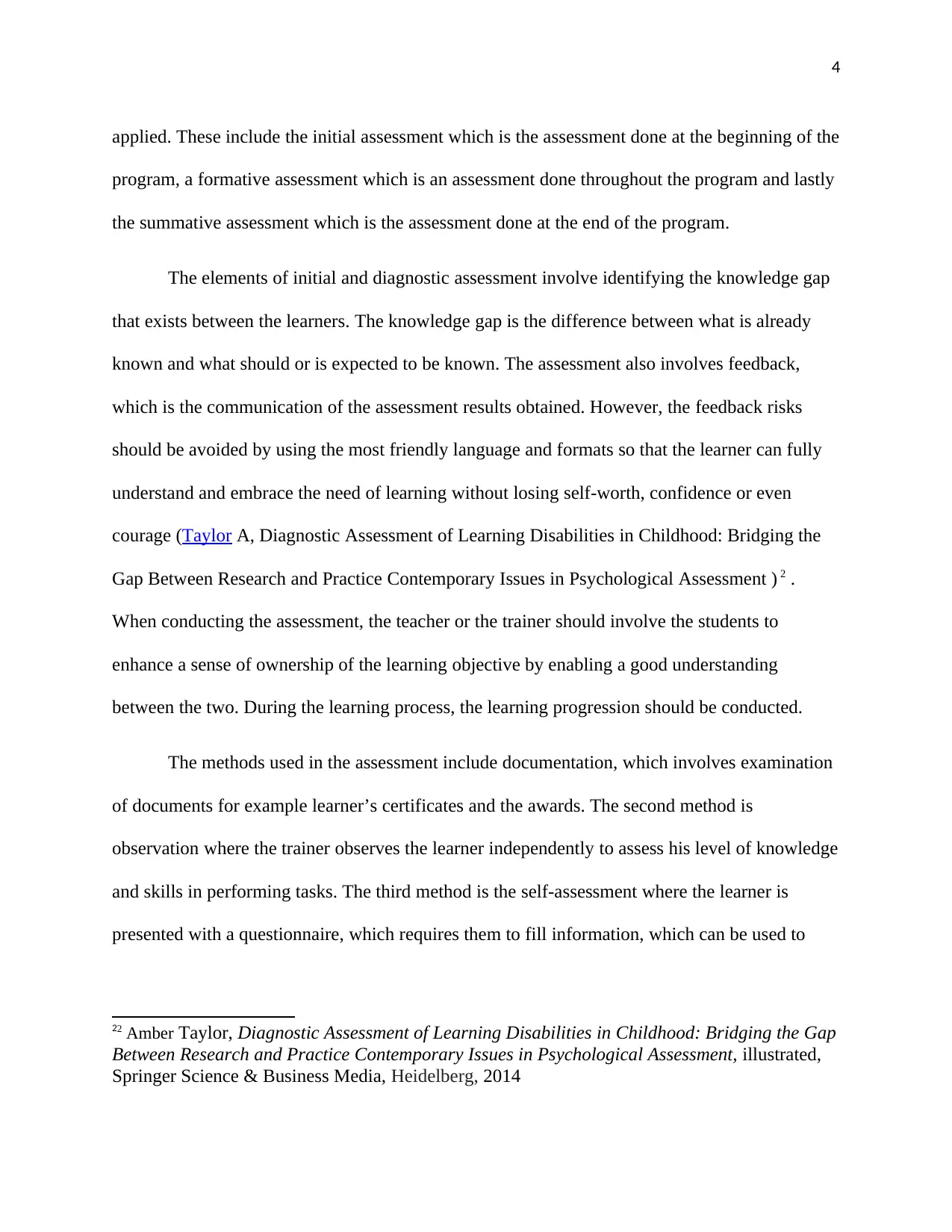
4
applied. These include the initial assessment which is the assessment done at the beginning of the
program, a formative assessment which is an assessment done throughout the program and lastly
the summative assessment which is the assessment done at the end of the program.
The elements of initial and diagnostic assessment involve identifying the knowledge gap
that exists between the learners. The knowledge gap is the difference between what is already
known and what should or is expected to be known. The assessment also involves feedback,
which is the communication of the assessment results obtained. However, the feedback risks
should be avoided by using the most friendly language and formats so that the learner can fully
understand and embrace the need of learning without losing self-worth, confidence or even
courage (Taylor A, Diagnostic Assessment of Learning Disabilities in Childhood: Bridging the
Gap Between Research and Practice Contemporary Issues in Psychological Assessment ) 2 .
When conducting the assessment, the teacher or the trainer should involve the students to
enhance a sense of ownership of the learning objective by enabling a good understanding
between the two. During the learning process, the learning progression should be conducted.
The methods used in the assessment include documentation, which involves examination
of documents for example learner’s certificates and the awards. The second method is
observation where the trainer observes the learner independently to assess his level of knowledge
and skills in performing tasks. The third method is the self-assessment where the learner is
presented with a questionnaire, which requires them to fill information, which can be used to
22 Amber Taylor, Diagnostic Assessment of Learning Disabilities in Childhood: Bridging the Gap
Between Research and Practice Contemporary Issues in Psychological Assessment, illustrated,
Springer Science & Business Media, Heidelberg, 2014
applied. These include the initial assessment which is the assessment done at the beginning of the
program, a formative assessment which is an assessment done throughout the program and lastly
the summative assessment which is the assessment done at the end of the program.
The elements of initial and diagnostic assessment involve identifying the knowledge gap
that exists between the learners. The knowledge gap is the difference between what is already
known and what should or is expected to be known. The assessment also involves feedback,
which is the communication of the assessment results obtained. However, the feedback risks
should be avoided by using the most friendly language and formats so that the learner can fully
understand and embrace the need of learning without losing self-worth, confidence or even
courage (Taylor A, Diagnostic Assessment of Learning Disabilities in Childhood: Bridging the
Gap Between Research and Practice Contemporary Issues in Psychological Assessment ) 2 .
When conducting the assessment, the teacher or the trainer should involve the students to
enhance a sense of ownership of the learning objective by enabling a good understanding
between the two. During the learning process, the learning progression should be conducted.
The methods used in the assessment include documentation, which involves examination
of documents for example learner’s certificates and the awards. The second method is
observation where the trainer observes the learner independently to assess his level of knowledge
and skills in performing tasks. The third method is the self-assessment where the learner is
presented with a questionnaire, which requires them to fill information, which can be used to
22 Amber Taylor, Diagnostic Assessment of Learning Disabilities in Childhood: Bridging the Gap
Between Research and Practice Contemporary Issues in Psychological Assessment, illustrated,
Springer Science & Business Media, Heidelberg, 2014
Paraphrase This Document
Need a fresh take? Get an instant paraphrase of this document with our AI Paraphraser

5
assess them. The fourth method involves structured activities. The fifth method involves a
discussion between the learner and the trainer.3
The organization where this report relates includes documents and self-analysis,
discussion, self-assessment and structured activities. The documents and self-analysis are used in
initial assessment when self-assessment, discussion, and structured activities are used for
diagnostic assessment. All these are aimed at the ultimate achievement of the learning objectives.
In the program, two learners were involved where their documents were analyzed, a
discussion was held, and they were asked to do a self-assessment. Since the learners were from a
calling center, structured activities were planned which took place in the actual center. When the
knowledge gap was identified, a decision for a learning program was made which involved the
two. The internal requirements were to be able to explain the expectation of their task outcomes,
be able to understand the purpose of their tasks and have the knowledge and skills required
performing their duties. The external requirements involved handling customers in confidence
and with high etiquettes. Present the organization with the most caring aspects and be able to
solve customer issues exhaustively.
After the assessment, a discussion with the learners was held on the importance and
purpose of the learning process that was to take place. In this regard, a human resource and
public relation officers were invited to the discussion where learner’s achievements, the
existence of knowledge gap were explained. The learning program plan was proposed which was
aimed at identifying and meeting the learners’ learning needs.
3
assess them. The fourth method involves structured activities. The fifth method involves a
discussion between the learner and the trainer.3
The organization where this report relates includes documents and self-analysis,
discussion, self-assessment and structured activities. The documents and self-analysis are used in
initial assessment when self-assessment, discussion, and structured activities are used for
diagnostic assessment. All these are aimed at the ultimate achievement of the learning objectives.
In the program, two learners were involved where their documents were analyzed, a
discussion was held, and they were asked to do a self-assessment. Since the learners were from a
calling center, structured activities were planned which took place in the actual center. When the
knowledge gap was identified, a decision for a learning program was made which involved the
two. The internal requirements were to be able to explain the expectation of their task outcomes,
be able to understand the purpose of their tasks and have the knowledge and skills required
performing their duties. The external requirements involved handling customers in confidence
and with high etiquettes. Present the organization with the most caring aspects and be able to
solve customer issues exhaustively.
After the assessment, a discussion with the learners was held on the importance and
purpose of the learning process that was to take place. In this regard, a human resource and
public relation officers were invited to the discussion where learner’s achievements, the
existence of knowledge gap were explained. The learning program plan was proposed which was
aimed at identifying and meeting the learners’ learning needs.
3
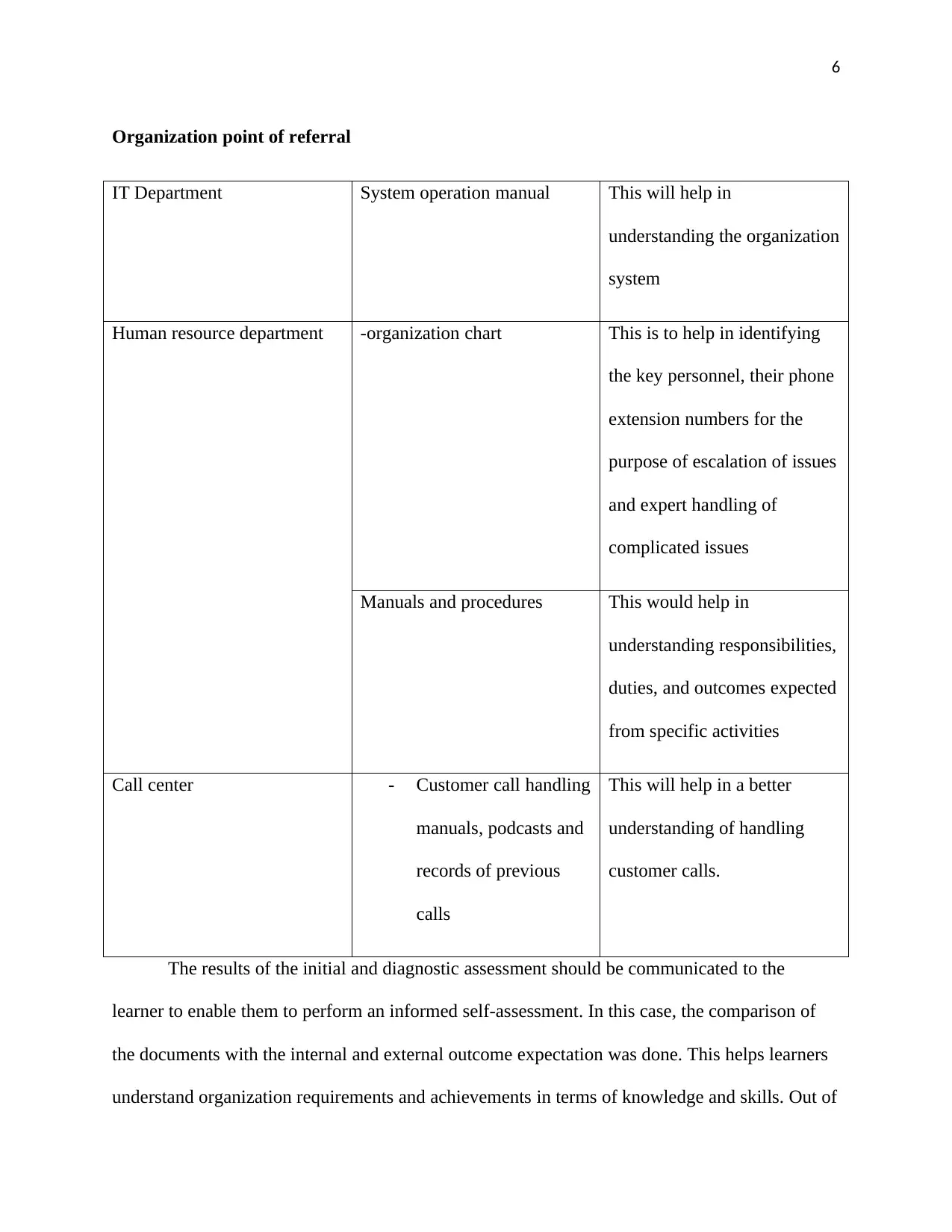
6
Organization point of referral
IT Department System operation manual This will help in
understanding the organization
system
Human resource department -organization chart This is to help in identifying
the key personnel, their phone
extension numbers for the
purpose of escalation of issues
and expert handling of
complicated issues
Manuals and procedures This would help in
understanding responsibilities,
duties, and outcomes expected
from specific activities
Call center - Customer call handling
manuals, podcasts and
records of previous
calls
This will help in a better
understanding of handling
customer calls.
The results of the initial and diagnostic assessment should be communicated to the
learner to enable them to perform an informed self-assessment. In this case, the comparison of
the documents with the internal and external outcome expectation was done. This helps learners
understand organization requirements and achievements in terms of knowledge and skills. Out of
Organization point of referral
IT Department System operation manual This will help in
understanding the organization
system
Human resource department -organization chart This is to help in identifying
the key personnel, their phone
extension numbers for the
purpose of escalation of issues
and expert handling of
complicated issues
Manuals and procedures This would help in
understanding responsibilities,
duties, and outcomes expected
from specific activities
Call center - Customer call handling
manuals, podcasts and
records of previous
calls
This will help in a better
understanding of handling
customer calls.
The results of the initial and diagnostic assessment should be communicated to the
learner to enable them to perform an informed self-assessment. In this case, the comparison of
the documents with the internal and external outcome expectation was done. This helps learners
understand organization requirements and achievements in terms of knowledge and skills. Out of
⊘ This is a preview!⊘
Do you want full access?
Subscribe today to unlock all pages.

Trusted by 1+ million students worldwide
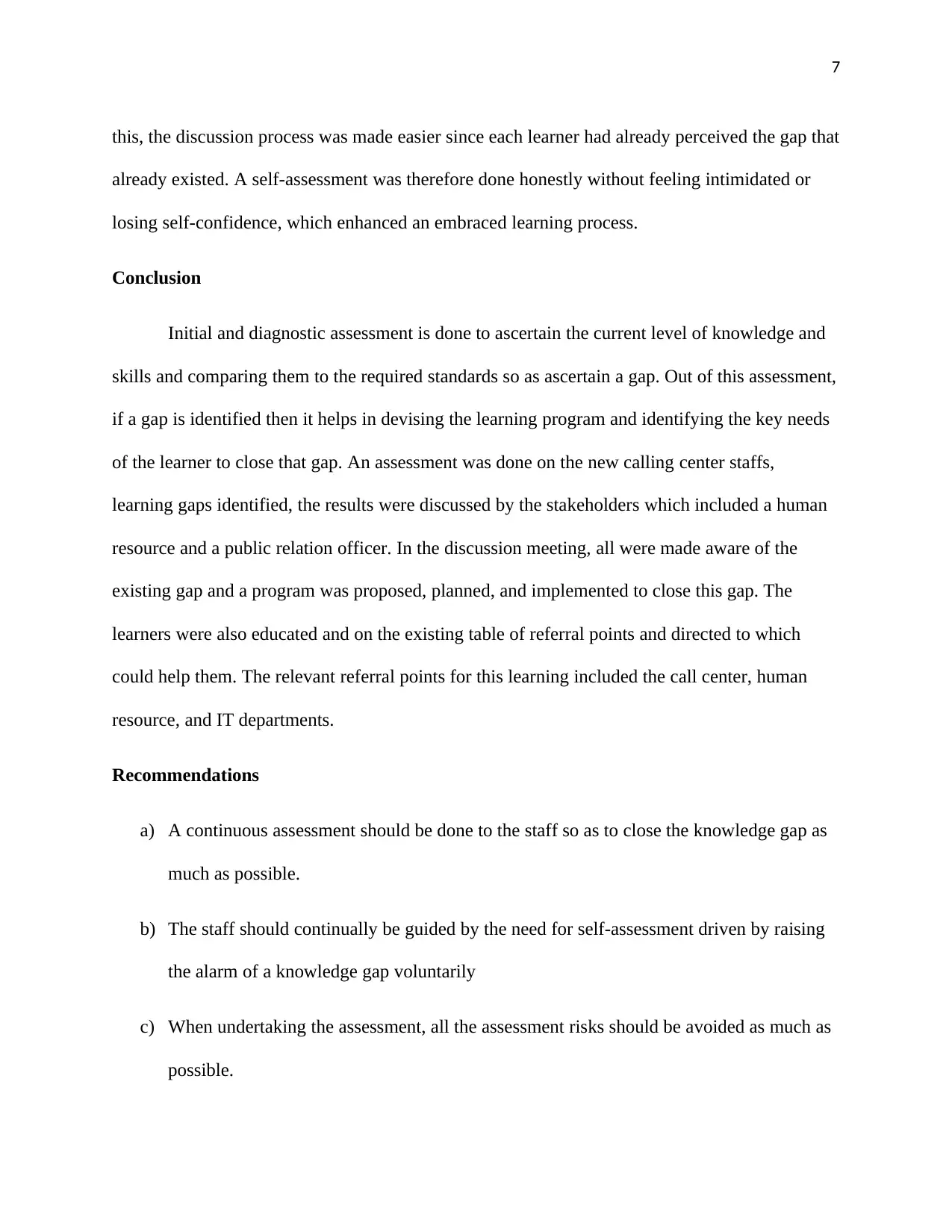
7
this, the discussion process was made easier since each learner had already perceived the gap that
already existed. A self-assessment was therefore done honestly without feeling intimidated or
losing self-confidence, which enhanced an embraced learning process.
Conclusion
Initial and diagnostic assessment is done to ascertain the current level of knowledge and
skills and comparing them to the required standards so as ascertain a gap. Out of this assessment,
if a gap is identified then it helps in devising the learning program and identifying the key needs
of the learner to close that gap. An assessment was done on the new calling center staffs,
learning gaps identified, the results were discussed by the stakeholders which included a human
resource and a public relation officer. In the discussion meeting, all were made aware of the
existing gap and a program was proposed, planned, and implemented to close this gap. The
learners were also educated and on the existing table of referral points and directed to which
could help them. The relevant referral points for this learning included the call center, human
resource, and IT departments.
Recommendations
a) A continuous assessment should be done to the staff so as to close the knowledge gap as
much as possible.
b) The staff should continually be guided by the need for self-assessment driven by raising
the alarm of a knowledge gap voluntarily
c) When undertaking the assessment, all the assessment risks should be avoided as much as
possible.
this, the discussion process was made easier since each learner had already perceived the gap that
already existed. A self-assessment was therefore done honestly without feeling intimidated or
losing self-confidence, which enhanced an embraced learning process.
Conclusion
Initial and diagnostic assessment is done to ascertain the current level of knowledge and
skills and comparing them to the required standards so as ascertain a gap. Out of this assessment,
if a gap is identified then it helps in devising the learning program and identifying the key needs
of the learner to close that gap. An assessment was done on the new calling center staffs,
learning gaps identified, the results were discussed by the stakeholders which included a human
resource and a public relation officer. In the discussion meeting, all were made aware of the
existing gap and a program was proposed, planned, and implemented to close this gap. The
learners were also educated and on the existing table of referral points and directed to which
could help them. The relevant referral points for this learning included the call center, human
resource, and IT departments.
Recommendations
a) A continuous assessment should be done to the staff so as to close the knowledge gap as
much as possible.
b) The staff should continually be guided by the need for self-assessment driven by raising
the alarm of a knowledge gap voluntarily
c) When undertaking the assessment, all the assessment risks should be avoided as much as
possible.
Paraphrase This Document
Need a fresh take? Get an instant paraphrase of this document with our AI Paraphraser

8
References
Zaidi, Nabeel, Meeting the Assessment Requirements of the Award in Education and Training,
Education and Training Consultants Ltd, New York, 2015
Taylor, Amber, Diagnostic Assessment of Learning Disabilities in Childhood: Bridging the Gap
Between Research and Practice Contemporary Issues in Psychological Assessment,
illustrated, Springer Science & Business Media, Heidelberg, 2014
References
Zaidi, Nabeel, Meeting the Assessment Requirements of the Award in Education and Training,
Education and Training Consultants Ltd, New York, 2015
Taylor, Amber, Diagnostic Assessment of Learning Disabilities in Childhood: Bridging the Gap
Between Research and Practice Contemporary Issues in Psychological Assessment,
illustrated, Springer Science & Business Media, Heidelberg, 2014
1 out of 8
Related Documents
Your All-in-One AI-Powered Toolkit for Academic Success.
+13062052269
info@desklib.com
Available 24*7 on WhatsApp / Email
![[object Object]](/_next/static/media/star-bottom.7253800d.svg)
Unlock your academic potential
Copyright © 2020–2025 A2Z Services. All Rights Reserved. Developed and managed by ZUCOL.





